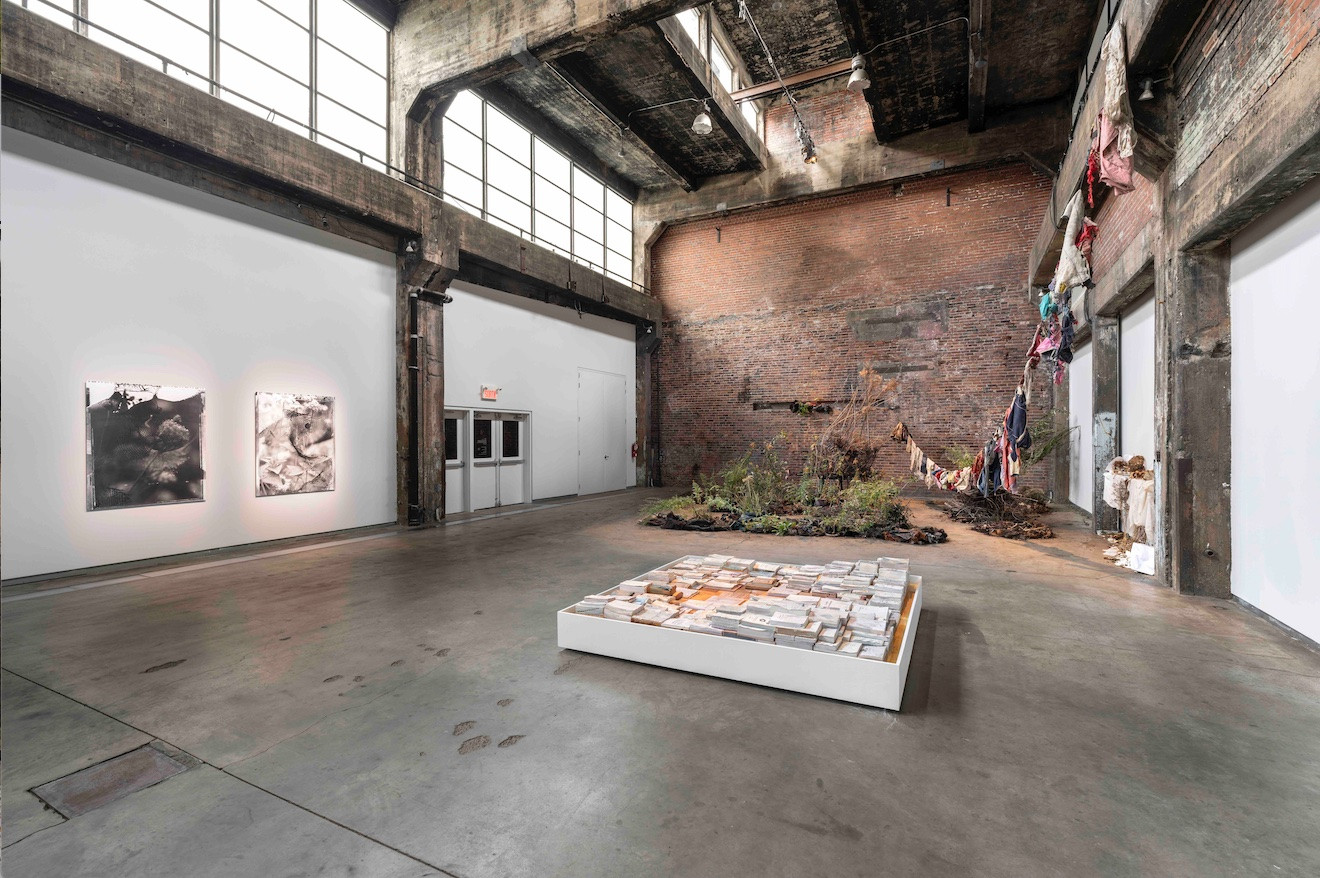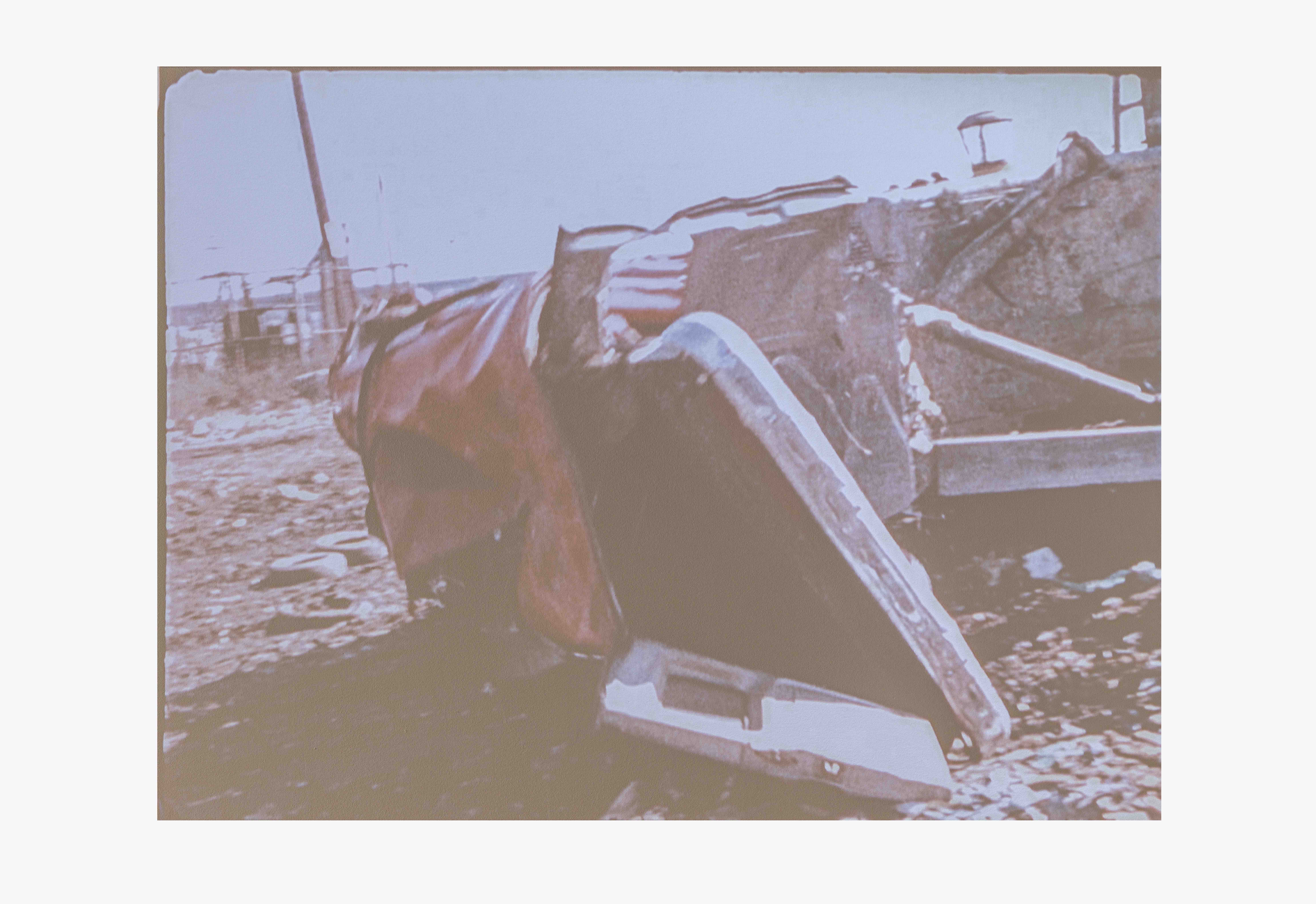






The group exhibition Déliquescence brings into dialogue works by Quebec and international artists around the theme of entropy. One of the fundamental principles of physics—the second law of thermodynamics—posits entropy as the inevitable decline of all things. The exhibition considers the definition of this concept as energy that measures deterioration, quantifies the intensity of the transformation from an ordered to an uncontrolled state, quantitatively establishes the degree of disorder in a system, its ability to change state, or its degree of instability. Whether it involves the collapse of ruins, the organic transformation of perishable materials, or the chemical processes that alter an object to the extent that it stops working, entropy represents the tendency of all matter and energy in the universe to evolve towards a state of disorder before reaching a neutrality, an inert uniformity, or a radical transformation into another condition. Left to their own disruption, the result of chemical or biological mutation, fusion or melting, each of these artistic proposals submits to an evolution towards decomposition, the abandonment of its defined form and the acceptance of its dissolution.
This exhibition was inspired by my ongoing interest in brownfields, which also undergo a type of entropy. My fascination for their status as ruins that slowly degrade over time and my interest in wanting to reverse this trend by restoring them are part of a constant negotiation with this form of obsolescence. Poeticizing decay or chaos, exalting the fragility of seemingly immutable elements have always been a driver for the projects I have carried out. With this exhibition and through the works chosen, I have wanted to underline the ineluctable transformation of every thing, be it alive or inanimate.
Allowed to malfunction or decay, due to a chemical or biological mutation, a principle of fusion or melting, each artwork in the exhibition undergoes an evolution towards decomposition, abandoning its defined form and accepting its disintegration.
LORNA BAUER, is a photographer and sculptor based in Quebec City. Her works evoke transitional states, openings to other forms, and mutations. Three photographs taken from two different series are presented in the exhibition. On a gravestone in Père Lachaise Cemetery (Père Lachaise, 2015), moss is slowly growing over an eroding inscription. In a frozen moment of a long transition from one state to another, the commemorative inscription engraved in the stone overrun by vegetation gradually shifts its appearance from a seemingly timeless immutability to a precarious fragility. Drawn from a recent series of photographs taken in a landfills (Décharges, 2024), two other images reveal insects bringing life to inanimate matter.
This exhibition draws on the research on entropy that American post-minimalist artists carried out in the 1970s. Based in Marseille, artist duo BERDAGUER & PÉJUS is interested in the writing that ROBERT SMITHSON published on the subject of entropy. To define the concept, SMITHSON puts forward as a metaphor a physics experiment that anyone can do: “I should now like to prove the irreversibility of eternity by using a jejune experiment for proving entropy. Picture in your mind’s eye the sand box divided in half with black sand on one side and white sand on the other. We take a child and have him run hundreds of times clockwise in the box until the sand gets mixed and begins to turn grey; after that we have him run anticlockwise, but the result will not be a restoration of the original division but a greater degree of greyness and an increase of entropy.” BERDAGUER & PÉJUS take up Smithson’s proposition word-for-word and carry out the experiment. Yet, in Timezone (2010), the video projection plays the action in reverse and, in a utopian turn, restores the state of deterioration, thereby recapturing Smithson’s other key concept of “ruins in reverse.”The artists take their peer's words at face value, with the aim of experimenting with his or her proposal. In Time Zone, however, the projection reverses the sequence of events, in a utopian fashion, making possible a restoration of the state of decay, echoing one of Smithson's key concepts from Ruins in reverse.
MICHEL BLAZY works with plant materials in installations and sculptures that reclaim the passing of time, reactivating their elements through the unpredictability of natural processes. His installations encourage us to question notions of beauty from an aesthetic perspective and challenge our repulsion in the face of decay by inviting us to observe freely evolving works. In the exhibition, the artist presents a monumental wall installation made out of tomato mold, which gradually reveals the beauty of the blue and green fungi taking over the red monochrome. Two sculptures made with an obsolete computers and printers are also shown in the grip of invasive vegetation that inexorably transforms these technological devices (Pull over time, 2013-2024).
Inspired by the dematerialization of data, Montreal artist SÉBASTIEN CLICHE creates installations that are constantly evolving and that convey his preoccupation with a perpetually mutating world. In Champ d’élagage (2024), the artist dunks books, as witnesses to contemporary culture, into chemical and crystalline solutions, making them gradually mutate towards a state of total decomposition. The salt gradually erodes the elements and transforms the volumes into uniform stuff formed by the accumulation of crystals, while the chemical products involved bring out certain hues, turning it into a poetic landscape. In Tableau des enregistrements (2024), plaster slabs imitating circuit boards are trapped in a salt bath and gradually transform, developing improbable excrescences.
Drawing inspiration from American minimalist art of the 1960s, sculptor ALEXANDRE DAVID is currently focusing on a systematic deconstruction and reconstruction of his works, limiting himself solely to their materials and making them evolve from one state to another. As the designer of the reading platform, a permanent element of the exhibition space where videos are presented regularly, David has been commissioned to transform his work as part of the exhibition’s general trend. His constraint is to integrate the film Fresh Kill by GORDON MATTA-CLARK, a significant research reference for the exhibition, into this space dedicated to cultural mediation, as he turns it into his work La suite (2017-2024).
KUH DEL ROSARIO’s art practice refers to alternative domains in which urban detritus is revitalized and transfigured into new forms. Her work puts forward the ideas that death does not imply a critical end but an opportunity to become “anew” and that time becomes manifest on the surface of ruins and departs from a trajectory of past, present, and future. The artist has created a specific installation in response to the exhibition’s theme: a sculpture-fountain formed from a canopy of crushed cans on which rainwater keeps dripping from the building’s roof. Channeling the liquid, vertical gutters water sculptures arranged on the ground that become altered over the exhibition’s duration as water oxidizes and crystalizes the elements used to make them.
GORDON MATTA-CLARK, an American post-minimalist artist of the late 1960s, and his contemporaries inspired the theme of this exhibition through their interest in the concept of entropy, particularly through works that put forward the principles of melting,fusion, and decay. In Fresh Kill (1972), presented for the first time at Documenta 5 in Kassel, a radical transformation is at work. The film documents the complete destruction of a truck brought to a dump, its compression and fusion into an amalgam of inanimate matter, while seagulls fly over the rubble, allowing us to imagine that a new destiny awaits this metal carcass.
EDITH DEKYNDT is interested in the creative process, in experimentation and transformation, before evenconsidering a work’s end. Thus, the artist resorts to natural strategies and resources to accompany this evolution, whether it be organic or chemical. Many of her works are in constant evolution, mutating into forms that sometimes remain indeterminate. Fascinated by process, experimentation, and physical transformation, the artist uses various strategies and natural resources to accompany the organic or chemical deterioration. On the one hand, the artist is presenting Underground 91530 Le Marais (2021), consisting of a large hanging that exalts the fabric’s deterioration as a result of being immersed in a swamp for several years. On the other hand, two small works, The Deodants (2015), appear in the guise of monochrome canvas stretched on a frame and also undergo the effects of accelerated decay from the introduction of chemical (calcium chloride) and organic (wine tartrates) products that alter their state over the course of the exhibition. These operations bear witness to the inevitability of deterioration and erosion, revealing the creative power of interchanges between materials.
Engaged in an eco-responsible practice for nearly thirty years, NICOLE MCDONALD-FOURNIER creates installations out of vegetation and recycled materials in order to question our life habits. Initially made in her backyard in 2012, and then hosted over several years on the Place Publique in front of the Darling Foundry’s buildings, the work Paysage Emballe-toi! aims to offer an innovative means of creating awareness of biodiversity and agriculture so as to green a particular site while also recycling scraps of synthetic textiles. In order to challenge our sartorial consumer habits, which involve buying a new coat every winter that is increasingly efficient in terms of heat retention and lightness, the artist buries recycled clothing, forcing it to decompose due to the power of the root systems of indigenous plants. The ecosystems that develop over the years with the insects and the ground’s organisms act as performers for the artist in this process she sets in motion.
A multidisciplinary artist based in Los Angeles, NOUR MOBARAK experiments with works and installations whose end remains uncertain. The artist works with mycelia and mushrooms, which she considers as her assistants, collaborators, or makers. She uses bodily substances and industrial residues, intimate and public detritus, to produce sculptural and pictorial assemblages that keep self-producing in random ways. Reproductive Logistics 3.2 (Back Pillow) (2023), a works made from a straw cushion and dried , shows the chance harmony between different organic materials. and oyster mushrooms.
This exhibition gathers works whose materiality, subject or end remain unfinished, and which, even if their evolution is interrupted, allow us to glimpse a continuity in a creative process within which the artist has let go. Déliquescence also tends to make us aware of the beauty of chaos, in the putrefaction, the degradation and the transformation of all things.
Text by curator Caroline Andrieux
Translated by Oana Avasilichioaei
Curator
Caroline Andrieux
